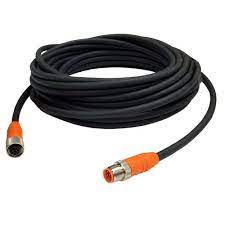In the vast landscape of industrial connectivity solutions, the M12 cable stands out as a versatile and robust option. With its compact design and reliable performance, it has become a staple in various applications across industries. Let's delve deeper into the intricacies of the M12 cable, exploring its specifications, differences from other variants, and its significance in modern industrial settings.
What is an M12 cable?
The M12 cable, also known as an M12 connector, is a circular electrical connector commonly used in industrial automation and networking applications. It features a screw-locking mechanism, ensuring secure connections in harsh environments where vibration and moisture are prevalent. The M12 connector typically comprises multiple pins, with configurations ranging from 2 to 8 pins, facilitating diverse communication protocols such as Ethernet, Profibus, DeviceNet, and more.
One of the defining characteristics of the M12 cable is its rugged construction, designed to withstand demanding conditions encountered in industrial environments. Its IP67 or IP68 rating ensures protection against dust, water ingress, and other contaminants, making it suitable for use in outdoor installations and harsh industrial settings. Helpful resource: https://www.te.com/usa-en/products/connectors/circular-connectors/intersection/m8m12.html#:~:text=The%20M12%20connector%20is%20a,%2C%208%2C%20and%2012%20pins.

What gauge is M12 wire?
The gauge of an M12 wire refers to the thickness or diameter of the conductor within the cable. M12 cables are available in various gauge sizes, typically ranging from 22 AWG (American Wire Gauge) to 26 AWG, with 22 AWG being the most common choice for industrial applications. The selection of the appropriate gauge depends on factors such as the power requirements of the devices being connected, the length of the cable run, and the voltage drop considerations.
The use of a thicker gauge, such as 22 AWG, allows for higher current-carrying capacity and reduced voltage drop over longer distances, ensuring reliable power transmission in industrial setups. However, for applications where space constraints or flexibility are crucial, smaller gauge sizes like 26 AWG may be preferred. Helpful resource: https://ctwireprep.com/why-are-m12-cables-so-famous/#:~:text=Standardly%2C%20M12%20cables%20have%200.034,per%20conductor%20for%20M12%20connections.
What is the difference between M8 and M12?
While both M8 and M12 connectors are popular choices for industrial connectivity, they differ primarily in their size and pin configurations. The M8 connector, as the name suggests, features a smaller circular form factor compared to the M12. It typically comes with 3 or 4 pins and is commonly used for sensor connections and other low-power applications where space is limited.
In contrast, the M12 connector offers a larger size and a wider range of pin configurations, making it suitable for diverse communication protocols and higher power requirements. Its robust design and screw-locking mechanism provide enhanced durability and reliability in challenging environments, making it a preferred choice for industrial automation, machinery, and networking applications. Helpful resource: https://sea.omega.com/sg/pptst/M8-M12FM.html#:~:text=M8%2FM12%20Series,-Field%20Mountable%20M8&text=The%20M12%20connectors%20feature%20convinient,to%20the%20limited%20space%20available.&text=M12%20Connectors%20Have%20Screw%20Connections%20for%20Wire%20Attachment.
In summary, the M12 cable emerges as a robust and versatile solution for industrial connectivity, offering reliable performance in harsh environments. Understanding its specifications, wire gauge options, and differences from other variants such as the M8 connector is essential for selecting the optimal solution to meet the specific requirements of industrial applications.
Facts Checked by Hugh Johnson
Hugh Johnson stands tall in the realms of both the chip industry and the electronic parts industry, earning acclaim as an esteemed expert in these fields. With an extensive background steeped in semiconductor technology, Hugh's expertise transcends chip design and fabrication, encompassing a profound understanding of electronic components' intricate functionalities and applications. His seasoned knowledge spans diverse facets, from microchip architecture and fabrication techniques to the broader landscape of electronic parts utilized across industries.









